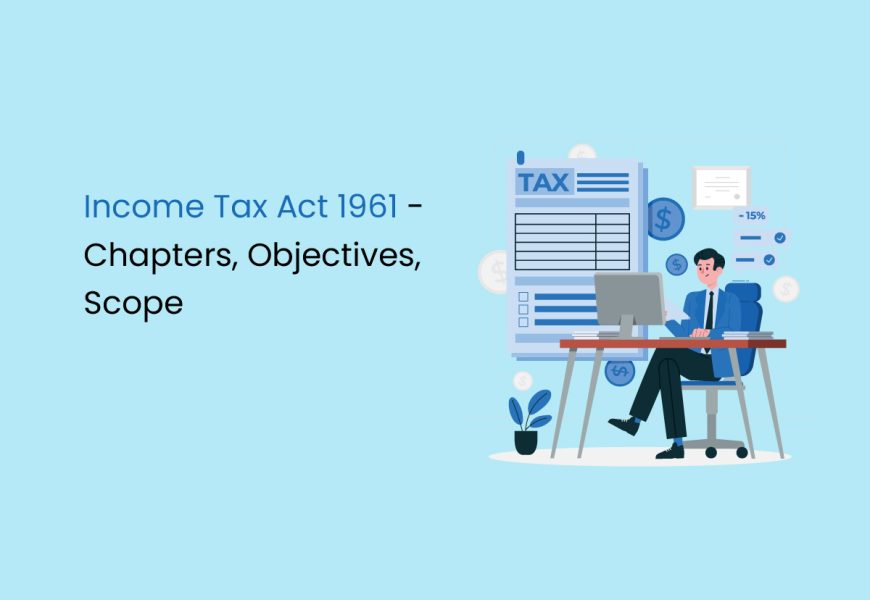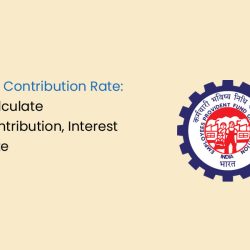Facing your first encounter with income tax? You’re not alone in seeking clarity amidst the confusion. Essential to this understanding is the Income Tax Act of 1961, a legislative framework crafted by the Government of India to guide the levying of taxes by the Income Tax Department.
Income tax, a fiscal imposition on the earnings of individuals or businesses within a designated financial year, is subject to computation based on income tax slabs. To unravel this complex concept, understanding the nuances within the Income Tax Act, including its various sections and provisions, comes first.
This article dives into the workings of Income Tax in India. Gain insights that let you deal with the complexities of taxation with confidence. Read on to discover more.
What is the Income Tax Act of 1961?
Enacted in 1961, the Income Tax Act stands as the comprehensive statute governing taxation matters in India. Covering aspects such as levy, collection, administration, and recovery of income tax, the act serves to consolidate and amend the rules associated with taxation in the country.
Comprising a multitude of sections, each addressing distinct facets of taxation, this intricate legislation plays a pivotal role. The Indian government, through its annual Finance budget unveiled in February, introduces amendments to the Income Tax Act. This dynamic process ensures that the tax framework aligns with evolving economic scenarios, making it crucial for taxpayers to stay informed and adapt to the changing landscape of fiscal policies.
IT Act and Related Sections and Sub-Sections
| Chapter | Explanation |
|---|---|
| Chapter I | This chapter serves as an introduction to the Income Tax Act, providing a foundational overview of its purpose and scope. |
| Chapter II | Chapter II discusses the commencement and geographical extent of the Income Tax Act, outlining when it comes into effect and its applicability. |
| Chapter III | Chapter III focuses on the charge of income tax, detailing the scope of total income, including dividend income and income arising from working abroad. |
| Chapter IV | This chapter deals with various forms of income that do not contribute to the total income, encompassing income from property, trusts, institutions, and political parties. |
| Chapter V | Chapter V addresses incomes of individuals that form part of the assessee’s income, covering capital gains, business income, and income from house property. |
| Chapter VI | Chapter VI delves into the transfer of income in cases where there is no actual transfer of assets, encompassing both transfer and revocable transfer. |
| Chapter VII | Chapter VII outlines deductions applicable to specific payments and incomes, providing insights into the permissible deductions. |
| Chapter VIII | Chapter VIII focuses on rebates and the share of members in an association or body, offering details on financial benefits and responsibilities. |
| Chapter IX | Chapter IX discusses double taxation relief, providing rebates on income tax and relief in income tax, especially in cases involving international transactions. |
| Chapter X | Chapter X deals with special provisions addressing the avoidance of payment of income tax, including agreements with foreign countries and measures to prevent tax evasion. |
| Chapter XA | Chapter XA introduces general anti-avoidance rules for income tax, outlining measures to prevent tax avoidance through various means. |
| Chapter XII | Chapter XII pertains to the calculation of tax under specific special cases, providing guidelines for unique scenarios. |
| Chapter XIIA | Chapter XIIA covers special provisions for incomes earned by Non-Resident Indians, including capital gains, short-term capital gains, and provident funds. |
| Chapter XIIB | Chapter XIIB lists special taxation provisions applicable to specific companies (sections 115J to 115JF), offering insights into the tax treatment of certain businesses. |
| Chapter XIIBB | Chapter XIIBB outlines the taxation process for the conversion of a foreign company into an Indian subsidiary, addressing the financial implications of such transactions. |
| Chapter XIIBBA | Chapter XIIBBA provides special rules for tax payment by individuals who are not engaged in business, offering a distinct framework for taxation in non-business scenarios. |
| Chapter XIIBC | Chapter XIIBC provides special provisions for foreign corporations based in India, detailing the tax treatment of these entities. |
| Chapter XIIC | Chapter XIIC addresses provisions related to retail trade in India, offering insights into the tax implications for businesses in the retail sector. |
| Chapter XIID | Chapter XIID deals with the taxation process for profits made by domestic companies, including interest payable on non-payment of taxes. |
| Chapter XIIDA | Chapter XIIDA lays down rules for tax on distributed income of a company, specifying the taxation of income distribution by companies. |
| Chapter XIIE | Chapter XIIE addresses tax on distributed income of unit holders, providing guidelines for the taxation of income distributed to unit holders. |
| Chapter XIIEA | Chapter XIIEA outlines special requirements for tax on income distributed by securitization trusts, addressing specific scenarios related to securitization. |
| Chapter XIIEB | Chapter XIIEB provides a special provision related to income accrued by certain institutions and trusts, detailing the tax treatment of income in these cases. |
| Chapter XIIF | Chapter XIIF deals with tax on income received from venture capital companies or venture capital funds, outlining the tax implications for venture capital investments. |
| Chapter XIIFA | Chapter XIIFA includes special provisions related to business trusts, offering insights into the taxation of income generated by business trusts. |
| Chapter XIIFB | Chapter XIIFB provides special provisions related to accrued income of investment funds and the taxation process associated with it. |
| Chapter XIIG | Chapter XIIG outlines special provisions with respect to the taxation of shipping companies, providing guidelines for taxation in the maritime industry. |
| Chapter XIIH | Chapter XIIH deals with income tax levied on fringe benefits, addressing the taxation of non-monetary benefits provided by employers. |
| Chapter XIII | Chapter XIII provides information about income tax authorities, including their appointment, control, jurisdiction, powers, and disclosure of information. |
| Chapter XIV | Chapter XIV covers return filing formalities, including obtaining PAN, filing returns online, methods of accounting, amendments, rectification of mistakes, intimation of loss, and related cases. |
| Chapter XIVA | Chapter XIVA provides provisions for avoiding repetitive appeals, particularly those already pending in higher courts, streamlining the appeals process. |
| Chapter XIVB | Chapter XIVB outlines special provisions for the evaluation of ‘search cases,’ addressing the tax implications in cases involving searches by authorities. |
| Chapter XV | Chapter XV lists down liabilities, both general and special, recovery of tax from non-resident Indians, private companies, and other related provisions, offering insights into taxpayer responsibilities. |
| Chapter XVI | Chapter XVI focuses on firms and their assessment and taxation process, including changes in constitution, succession, and dissolution processes. |
| Chapter XVII | Chapter XVII lists clauses related to the collection and recovery of tax, including interest charged on late payments, outlining measures for effective tax collection. |
| Chapter XVIII | Chapter XVIII provides income tax relief to companies paying dividends to their shareholders and those involved in charitable work through their foundation wings, encouraging certain corporate behaviors. |
| Chapter XIX | Chapter XIX deals with refunds related to taxes, covering scenarios where excess tax is paid, eligibility for refunds, correctness of assessment, and interest on refunds. |
| Chapter XIXA | Chapter XIXA addresses the settlement of cases, covering application procedures, abatement of proceedings, and recovery of sums, providing a framework for resolving tax disputes. |
| Chapter XIX-AA | Chapter XIX-AA pertains to the establishment of dispute resolution committees by the Central Government for resolving disputes involving specified persons, introducing an alternative mechanism for dispute resolution. |
| Chapter XIXB | Chapter XIXB covers advance rulings, including sections 245N to 245V, addressing application processes, authority powers, and related topics, providing a mechanism for obtaining clarity on tax matters in advance. |
| Chapter XX | Chapter XX deals with appeals to deputy commissioners, commissioners, high courts, and the Supreme Court, along with general aspects of revision by commissioners, offering avenues for challenging tax decisions. |
| Chapter XXA | Chapter XXA includes sections 269A to 269S and is related to the acquisition of immovable properties in certain cases to counteract tax evasion, providing measures to prevent tax evasion through property transactions. |
| Chapter XXB | Chapter XXB lists modes of payment for cases requiring correction of tax evasion, including taking and accepting loans and deposits for the same and their corresponding modes, detailing methods to rectify tax evasion. |
| Chapter XXC | Chapter XXC deals with the purchase of immovable properties by the central government in cases of transfer, including restrictions on the property, appropriate authority, rectification of mistakes, and vesting of property, providing guidelines for government acquisitions. |
| Chapter XXI | Chapter XXI (sections 271 to 275) covers penalties applicable to various taxpayers in cases of non-disclosure, non-payment of taxes, and failure to comply with various provisions, outlining consequences for non-compliance. |
| Chapter XXII | Chapter XXII includes sections related to offences and the corresponding punishments, detailing legal consequences for specific violations. |
| Chapter XXIIB | Chapter XXIIB notes the sections (280Y, 280Z, 280ZA, 280ZB, 280ZC, 280ZD, and 280ZE) that were removed with effect from April 1, 1990, and provides additional context on tax credit certificates, offering historical insights into legislative changes. |
| Chapter XXI | Chapter XXI (sections 275A to 280D) addresses prosecution and offences related to compliance failure and other details about how the prosecution process will be taken forward, outlining legal procedures in case of non-compliance. |
| Chapter XXIII | Chapter XXIII (sections 281 to 298) covers miscellaneous topics that cannot be put under any of the specific tax chapters stated above, containing generic as well as special cases that may arise with respect to the taxation process for various taxpaying entities. |
Main Objectives of the Income Tax of 1961
The main objectives of the Income Tax Act of 1961 are multifaceted, encompassing economic stability, employment generation, progressive taxation, control of cyclical fluctuations, and addressing balance of payment concerns. Here’s an elaboration on each objective:
Price Stability
The IT Act aims to maintain price stability in the economy by regulating direct taxes. It helps control private spending, contributing to the overall stability of commodity prices.
Full Employment
The Act strives to promote full employment opportunities within the economy. By reducing income tax rates, it aims to stimulate higher demand for goods and services, leading to more job opportunities.
Non-Revenue Objective
The Income Tax Act addresses wealth inequality among citizens through a progressive taxation system. Higher tax rates are applied to wealthier individuals, promoting a fair distribution of wealth.
Cyclical Fluctuations Control
The Act adjusts income tax rates based on economic conditions to control cyclical fluctuations. During economic booms, tax rates may increase to manage excessive spending, while in times of recession, rates may be reduced to stimulate economic activity.
Reducing Balance of Payment Issues
The Income Tax Act imposes customs duties on certain imported goods to address the balance of payment difficulties. This encourages domestic production, reducing reliance on imports and supporting economic self-sufficiency.
Scope of Income Tax Act
| Income Type | Resident and Ordinarily Resident (ROR) | Resident but not Ordinarily Resident (RNOR) | Non-Resident (NR) |
|---|---|---|---|
| Income received or deemed to be received in India | Taxable | Taxable | Taxable |
| Accrued income in India | Taxable | Taxable | Taxable |
| Income accrues from outside India, but the profession or business is inside the country. | Taxable | Taxable | Non-taxable |
| Income accrues from outside India, but the profession or business is outside the country. | Taxable | Non-taxable | Non-taxable |
| The untaxed past foreign income brought into the country. | Non-taxable | Non-taxable | Non-taxable |
The scope or extent of tax implications under the Income Tax Act 1961 depends upon the assessee’s residential status, which includes Resident and Ordinarily Resident (ROR), Resident but not Ordinarily Resident (RNOR), and Non-Resident (NR). The table summarises the taxability of different income types based on the residential status of the assessee.
Features: Income Tax Act of 1961
The Income Tax Act of 1961 incorporates several notable features, contributing to its structure and functionality:
- Direct Tax Nature: Income tax is a direct tax, implying that the taxpayer is directly responsible for bearing this tax burden. It cannot be transferred to another individual.
- Central Government Control: The Income Tax Act is under the jurisdiction and control of the Central Government of India. The central authority governs the administration, enforcement, and amendments related to income tax.
- Applicability to Previous Year’s Income: Income tax is applicable to the income earned by the taxpayer in the previous financial year. The tax liability is determined based on the income generated during this period.
- Tax Calculation Based on Slabs: The calculation of income tax is based on the assessee’s income tax slab. The tax slabs are structured in a progressive manner, with higher income levels incurring higher tax rates.
- Progressive Taxation: The Income Tax Act employs a progressive income tax rate. This means that individuals with higher incomes are subjected to higher tax rates. This progressive structure is designed to ensure that affluent individuals contribute a larger share of their income in taxes.
- Deductions with Maximum Limits: Certain deductions are allowed under the Income Tax Act, providing taxpayers with the opportunity to reduce their taxable income. However, these deductions are subject to maximum limits specified for each financial year.
These features collectively contribute to the design and implementation of the Income Tax Act 1961, creating a system that aims to distribute the tax burden fairly while offering certain provisions for deductions to eligible taxpayers.
Provisions of the Income Tax Act
The Income Tax Act 1961 encompasses various provisions governing different taxation aspects. Some notable provisions include;
- Appeal to the High Court and Supreme Court: Provisions under Section 260A allow taxpayers to appeal to the High Court, while Section 261 pertains to appeals to the Supreme Court. These provisions establish legal avenues for challenging tax-related decisions.
- Annual Information and Financial Transaction Statement: The Act includes provisions related to the submission and assessment of an annual information and financial transaction statement. This is a comprehensive disclosure mechanism for financial transactions.
- Appearance by an Authorised Representative: The Act outlines provisions allowing taxpayers to be represented by an authorised representative during tax-related proceedings. This representative acts on behalf of the taxpayer in dealings with tax authorities.
- Income Taxability: Provisions in the Income Tax Act define the criteria and parameters for determining the taxability of various types of income, ensuring a systematic approach to taxation.
- Undertaking Transactions Mode: The Act includes provisions detailing the mode and conduct of undertaking transactions. This encompasses guidelines for executing financial transactions in compliance with tax regulations.
- Assessing Tax Authorities: The Act establishes provisions related to assessing tax authorities’ roles, powers, and responsibilities. These authorities are crucial in evaluating taxpayers’ financial information for tax assessment.
- Instructions to Subordinate Authorities: Provisions exist for issuing instructions to subordinate tax authorities. This ensures consistency and adherence to standardised procedures in implementing tax laws.
- Appeal Application for Reference by the Income Tax Officer: The Act provides for the application for reference by the Income Tax Officer, allowing for clarification or guidance on specific tax-related matters.
These provisions collectively form the framework for administering and enforcing the Income Tax Act 1961, covering legal aspects, disclosure requirements, representation, taxability criteria, transaction modes, and the roles of assessing and subordinate authorities.
FAQs On Income Tax Act
How many sections are there in the Income Tax Act 1961?
The Income Tax Act of 1961 comprises 298 sections distributed across 23 chapters. Key sections include Section 80C, Section 80CCD, Section 80CCC, Section 80TTA, and Section 80TTB.
What are the main objectives of the Income Tax Act 1961?
The primary objectives of the Income Tax Act include promoting price stability, full employment, economic development, reduction of balance of payment difficulties, controlling cyclical fluctuations, and achieving non-revenue objectives.
What is the basic concept of the Income Tax Act?
The Income Tax Act establishes income tax as a direct tax, directly borne by the taxpayer and not transferable. The Central Government of India oversees this form of taxation, applicable to the taxpayer's income earned in the previous year.
How many income tax acts are there?
The Income Tax Act of 1961 is a comprehensive statute governing taxation in India, consisting of 23 chapters and 298 sections, as outlined by the official website of the Income Tax Department of India.




















